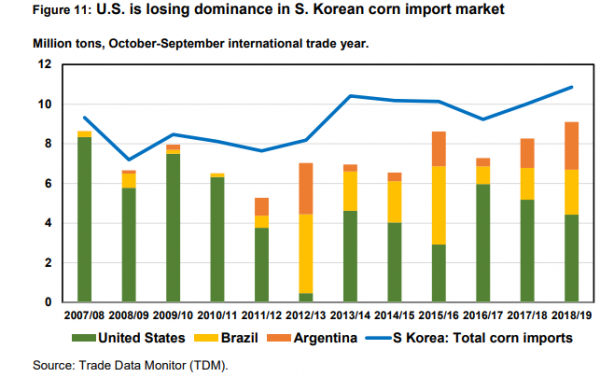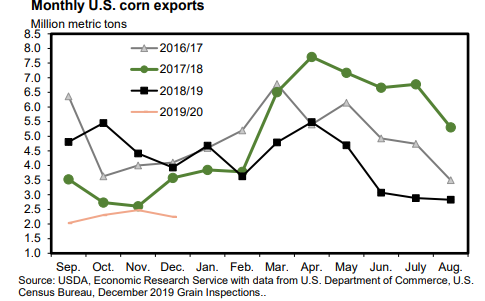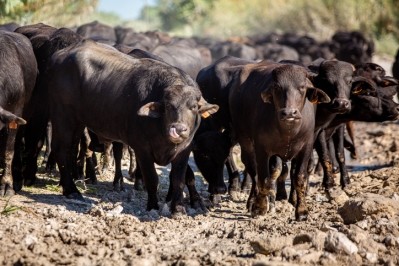USDA: US feed use, animal production expected to grow

The US Department of Agriculture (USDA) released updated projections about livestock, feed and feed grain use and production for the 2019/20 marketing year Tuesday [January 14] in a new feed outlook report from the Economic Research Service.
Overall, US corn ending stocks are predicted to fall for 2019/20 although beginning stocks for the year were higher than initially anticipated, said report authors Tom Capehart, Olga Liefert and David Olson. But, the increase was offset by “stronger-than-expected domestic demand” for the first several months of the marketing year and total corn use has been increased by 155m bushels.
“First quarter 2019/20 (September-November) feed and residual is a record high at 2,640m bushels,” they added.
Globally, there have been shifts in trade for major corn exporters as Brazil and Ukraine are expected to see an increase in corn exports while anticipated corn exports for the US were trimmed 4%, they said.
“Increased competition limits US exports, despite expected record global corn trade,” they said. “Global trade in sorghum and barley are projected higher.”
Corn and coarse grains production
US corn production for the 2019/20 marketing year has been increased 31m bushels to 13.69bn, the report authors said. Lower acreage was offset by an increase in yield.
“With total use projected at 14,070m bushels, ending stocks are pegged at 1,892m and stocks-to-use are projected slightly tighter at 13.4, compared with 13.7 last month,” they said.
Sorghum production is expected to drop in 2019/20, the authors said. The crop is predicted to decline 16m bushels to 341m bushels and see about 50,000 bushels in imports.
“Feed and residual use is lowered 20 million bushels to 140m, based on indicated disappearance during the September to November quarter,” they added.
Grain-consuming animal units
The number of animals in production during 2019/20 has been increased, the report authors said. Grain-consuming animal units (GCAU) are expected to reach 102.84m units.
Animal units produced in 2018/19 are estimated to be about 100.73m units, they added.
“Estimated January 1 inventories fell this month for dairy and beef cattle, broilers, and layers, and also declined for beef cattle and turkeys,” they said. “However, estimated January 1 inventories rose for layers, broilers, and hogs.”
Feed use predictions
Use of four feed grains – corn, sorghum, barley and oats – and wheat in the US is projected to reach 150.5m tons during 2019/20, the report authors said. The predicted usage amount is an increase on earlier estimates.
“Feed and residual for corn and sorghum increased while barley and wheat declined,” they said. “Feed and residual per GCAU increased slightly to 1.5 tons per GCAU.”
Feed and residual use of corn was increased by 250m bushels to 5.5bn, they added.
Globally, feed use in 2019/20 is anticipated to increase by 6.3m tons, based, in part, on higher feed use in the US, they said. China is expected to see a large shift in the use of barley to corn in feed.
“Even with higher projected barley imports, Chinese barley feed use is projected to decline,” the authors said. “A 0.9-million-ton reduction in barley feed and residual use is expected to be more than offset by corn feeding, which is projected up 1m tons to 190m, leaving Chinese coarse grain use slightly higher.”
The feeding of coarse grain in the EU is predicted to decline based on production changes and partially offset by increased use of barley, they said. Ukraine is expected to see a drop in feed use, while Russia and Bangladesh expand the amount of corn used in feed.
US, global feed grain exports
Export sales and shipments of US corn in the first four months of the marketing year are matching the low established in the drought year 2012/13, the authors said. Total shipments have been 268.7m bushels – down from the 632.1m bushels moved during the same period the previous year.
Globally, exports from South America and Ukraine are expected to curb US sales, they said. Brazil has set a record pace for corn sales and Ukraine saw exports reach 30.5m tons.
“Despite high global corn trade, US market share in the major corn importing countries has become highly dependent on the crop size in Brazil, Argentina, and Ukraine, as large crops in those countries boost their price competitiveness and tend to limit US exports,” they said. “Even in traditional stable US import markets, such as Japan, Korea, and Taiwan, where the United States used to reign as the top foreign supplier, it is losing market shares.”
However, US sorghum exports are expected to increase to 120m bushels based on sales to Mexico and shipments for unknown destinations, they said.
“Exports during the first quarter of 2019/20 reached 24.5m bushels compared with 15.9m bushels during the same period last year,” the authors said. “Much of the increase is due to shipments to Mexico, which increased from 4.7m bushels to 8m.”
Global trade in sorghum is anticipated to increase by almost 6% based on US exports, they said.
Trade in barley also increased with higher imports from Turkey and China, they said. “Turkish barley imports (which come mainly from Ukraine) are projected 0.6m tons higher at 0.7m and are expected to be used mostly in the country’s poultry industry,” they added.
The EU is expected to see increased barley exports along with Ukraine and Argentina, however, they were down for Australia, they said.

















